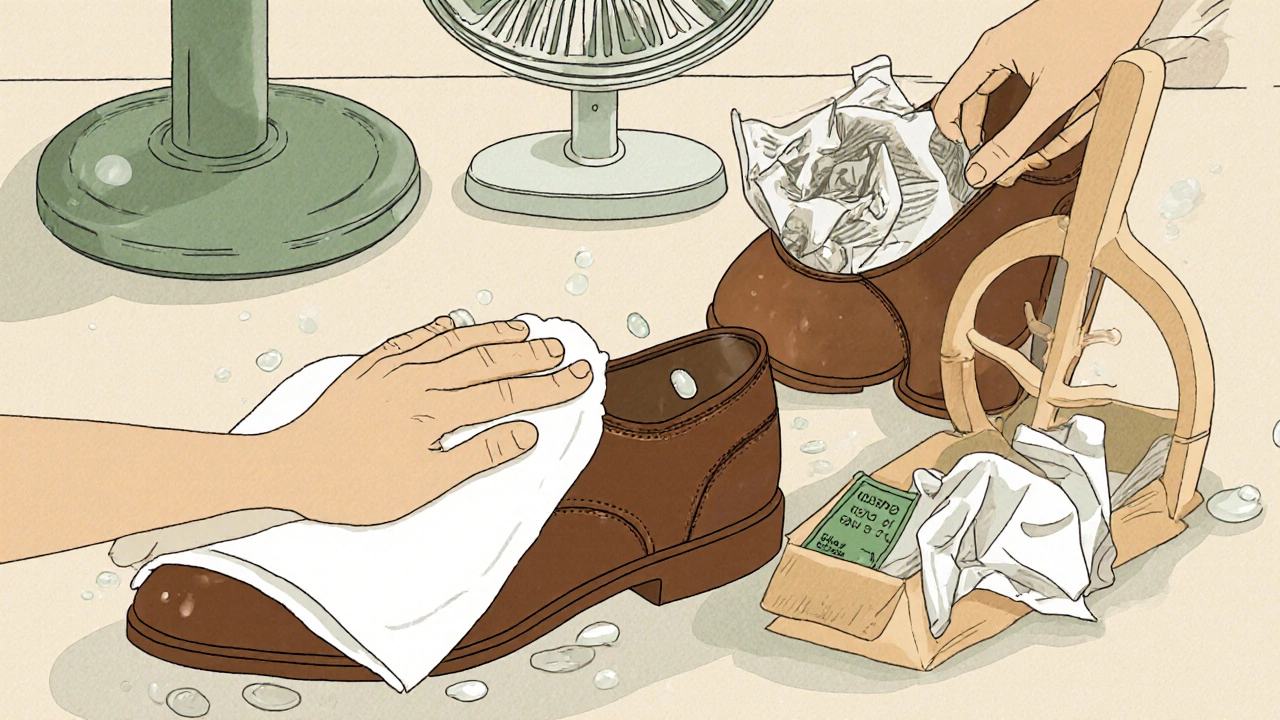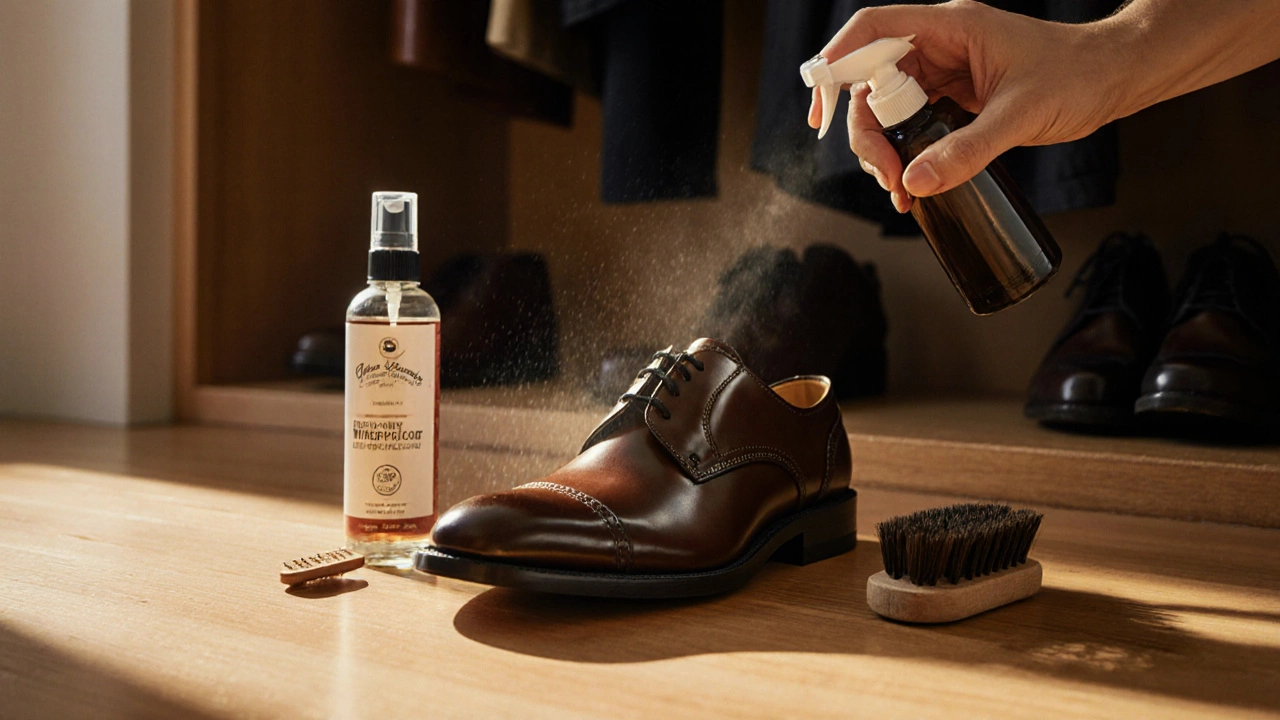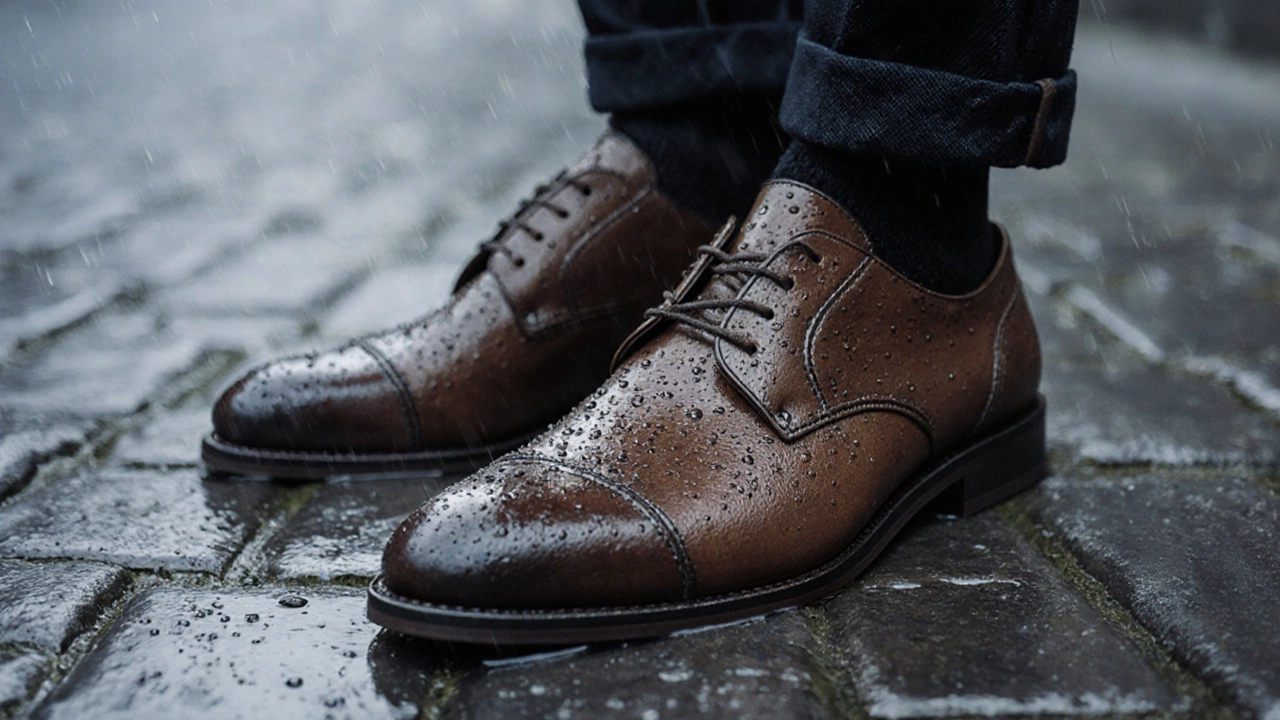Leather Shoe Rescue Calculator
Your Wet Leather Shoe Rescue Plan
Select your leather type to get personalized drying and restoration instructions.
Your Action Plan
When leather shoes get caught in rain or a spill, the first question is whether they’re ruined or if they can be rescued, the answer isn’t a simple yes or no. It depends on the type of leather, how quickly you act, and the care steps you follow. Below you’ll find a step‑by‑step guide that turns a soggy mishap into a manageable repair job.
Why Water Harms Leather
Leather is a natural protein fiber that swells when it absorbs moisture. The swelling can stretch the grain, weaken the stitching, and cause stains as minerals settle on the surface. If the leather stays damp for too long, the fibers break down and the finish-whether it’s a pigmented coating or an oiled surface-can crack. In short, water can affect three main areas:
- Absorption: Full‑grain leather can soak up to 20% of its weight in water, while treated leathers absorb far less.
- Staining: Minerals in tap water leave dark marks; rain can deposit pollen or road grime.
- Structural integrity: Prolonged moisture weakens glue joints, especially on rubber soles.
Leather Types and Their Water Tolerance
| Leather Type | Typical Water Absorption | Stain Resistance | Best Care after Getting Wet |
|---|---|---|---|
| Full‑grain leather | High (up to 20% weight) | Low - prone to dark spots | Pat dry, apply conditioner, use waterproofing spray |
| Top‑grain leather | Medium (10‑15% weight) | Moderate - finishes help | Blot, air‑dry, re‑condition |
| Suede / Nubuck | Very high - open pores | Very low - easily stained | Do not use water; brush with suede eraser, use specialized cleaner |
| Patent leather | Low - sealed surface | High - water beads | Wipe with a soft cloth, dry immediately |
Immediate Actions: What to Do the Moment Your Shoes Get Wet
- Blot, don’t rub. Use a clean, dry towel or soft cloth to absorb excess water. Press gently to avoid pushing water deeper into the leather.
- Remove insoles and laces. This speeds up drying and prevents the interior from staying damp.
- Insert a shoe tree or crumpled newspaper. A shoe tree helps maintain shape while drawing moisture away. If you don’t have a tree, loosely pack newspaper inside; change it every hour.
- Avoid direct heat. Never place leather shoes on a radiator, in front of a hair dryer, or in a sunny window. High heat dries the surface too fast, causing the leather to harden and crack.

Effective Drying Methods
Once you’ve blotted and set up a drying aid, choose a method that balances speed with gentleness.
- Room‑temperature air drying. Place shoes in a well‑ventilated area (e.g., near a fan) and let them dry naturally for 12‑24 hours.
- Drying rack with low‑heat circulation. If you have a shoe dryer that circulates warm (not hot) air at 30‑35 °C, it’s safe for most leathers.
- Silica gel packets. Fill a zip‑lock bag with silica packets and nest the shoes inside; this method is excellent for travel emergencies.
Remember, the key is slow, even drying. If you notice the leather stiffening, lightly mist the surface with water and reshape it with your hands.
Restoration: Cleaning, Conditioning, and Waterproofing
After the shoes are completely dry, treat them to bring back softness and protect them from future spills.
- Clean the surface. Use a soft leather cleaner or a mixture of equal parts water and white vinegar for light stains. Apply with a microfiber cloth, then wipe off any residue.
- Apply a leather conditioner. Choose a product suited to your leather type-e.g., a bovine‑fat‑based conditioner for full‑grain, a silicone‑free formula for patent. Work a pea‑sized amount into the leather using circular motions, let it absorb for 15 minutes, then buff with a soft brush.
- Seal with a waterproofing spray. Look for a spray that lists “breathable” and “non‑darkening” on the label. Hold the can 6‑8 inches away and mist evenly. Allow 24 hours before wearing.

Prevention: Everyday Habits That Keep Shoes Dry
- Apply a waterproofing spray quarterly, especially before rainy seasons.
- Use a leather protector cream after each deep clean.
- Choose shoes with rubber soles that have a water‑repellent coating.
- Carry a small travel‑size shoe brush and a dry cloth in your bag for quick spot treatment.
Common Mistakes to Avoid
Even well‑intentioned care can backfire. Here are pitfalls that turn a rescue into permanent damage:
- Using a hair dryer or radiator. The heat shrinks the fibers, cracking the grain.
- Applying oil‑based conditioners on patent leather. It makes the surface sticky and dull.
- Rubbing wet leather with a brush. This spreads moisture deeper.
- Skipping the drying aids. Shoes lose shape and develop creases.
Quick Checklist for Wet Leather Shoes
- Blot excess water immediately.
- Remove insoles and laces.
- Insert shoe tree or newspaper.
- Avoid direct heat; use room‑temperature air.
- Clean, condition, then waterproof after dry.
Can I use a hair dryer to speed up drying?
No. High heat dries the surface too fast, causing the leather to stiffen and crack. Stick to cool air or a low‑heat dryer specifically designed for shoes.
Is it safe to wear shoes while they are still damp?
It’s best to wait until they are completely dry. Wearing damp shoes can stretch the leather and create an odor.
Do suede shoes need a different rescue plan?
Yes. Suede absorbs water quickly and stains easily. Instead of water, use a suede brush and a specialized suede cleaner. If it gets wet, let it air dry naturally and then revive the nap with a suede eraser.
How often should I re‑apply waterproofing spray?
Apply a fresh coat every three to four months, or after each thorough cleaning. In rainy climates, a monthly routine works best.
Will using newspaper damage the leather?
No. Crumpled newspaper is absorbent and safe as long as you change it regularly to keep moisture away from the interior.

